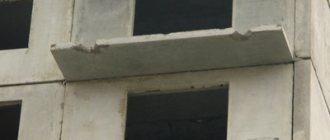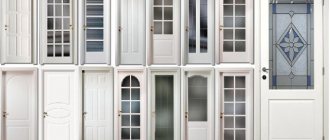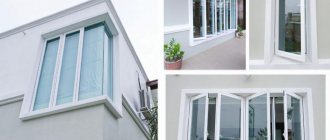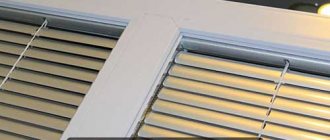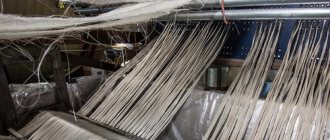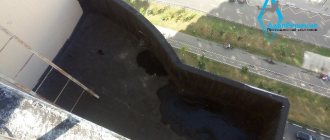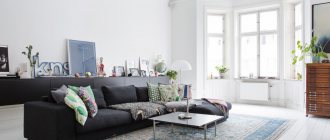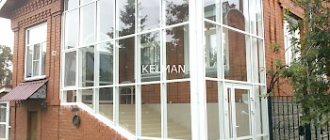OSB stands for Oriented Strand Board - a board made of oriented strands, or OSB in Russian. This is a modern construction and finishing material, consisting of 90% wood chips bound with synthetic waterproof resins. The slabs are formed by 3-4 layers of thin chips up to 15 cm long, pressed at high pressure and temperature, and the direction of the chips in each layer is different.
OSB boards can be used for:
- production of sandwich panels and construction of frame houses,
- when constructing floors, stairs,
- covering walls, ceilings, floors,
- for covering roofs,
- during auxiliary work (installation of formwork, scaffolding),
- for the manufacture of auxiliary buildings (sheds, storage facilities), street structures, fences,
- as structural elements of furniture.
High-quality OSB complies with the EN 300 OSB standard, which sets requirements for environmental safety and technical parameters of boards.
Kinds
Oriented strand boards are divided into 4 types based on strength and moisture resistance.
These boards consist of wood chips glued together with a single resin. OSB-1 has low moisture resistance and resistance to mechanical stress. They also cannot withstand heavy loads. OSB is used only in dry rooms protected from moisture penetration. The cost of OSB-1 is lower than others; it is rarely used due to its low characteristics. Such sheets are difficult to find in building materials warehouses.
Unlike the previous version, OSB-2 can withstand heavy loads. Their humidity index is slightly higher, but still low. The slabs are used indoors in residential premises without high air humidity. A suitable option for walls are models with a thickness of 8-12 mm. Products with a thickness of 15 mm are used for the production of furniture, for example, shelves, countertops, cabinets.
Important
OSB-2 can be used for finishing rooms with high levels of humidity if they are coated with a protective agent.
OSB is made with 2 types of resins. In the center, the shavings are connected with polyurethane glue. From the outside it is glued together with durable organic resins. OSB-3 is widely used in construction.
OSB-3 is more often used for wall finishing due to its resistance to moisture, as well as strength. It is used not only inside, but also outside the house. Models with a thickness of 22 mm are suitable for rigid roof sheathing. From them you can get strong load-bearing structures.
OSB-4 is one of the most moisture-resistant durable panels. The material can withstand loads and is used for finishing walls and cladding facades of houses. The main disadvantage is that it is expensive, so it is not widely used.
How to sheathe OSB outside and inside the house, tips and instructions
Today OSB panels are so popular that they are often used in repairs and construction for both interior and exterior decoration. Of course, with the right approach, it is even possible to paint OSB, or plaster on OSB, or stick wallpaper, but all this is not very reliable, and the result will even be costly. If you try hard, you can even lay tiles on this material, but how long it all lasts may depend on many factors, and such finishing is not at all applicable for exterior work.
Therefore, many are wondering how to cover the outside of OSB so that it lasts a long time, does not rot, and is not expensive. In our instructions you will learn this, familiarize yourself with the necessary tools, and most importantly, how to do it all correctly.
How to choose OSB
When choosing a material, you need to pay attention to its dimensions, manufacturer, and type.
4.1 Size
For finishing, choose sheets measuring 1250x2500 mm (European standard) or 1220x2440 mm (North American standard). There are panels on the market with a length of 3000 mm and 3150 mm. The maximum length can reach 7000 mm. They are made to order. The width of the panels does not change much.
It is recommended to use large slabs. This will ensure the least number of joints after installation, which is important for finishing the walls, ceiling and floor of a frame house. The panels must cover the entire height. The thickness of the slabs is 6-25 mm, its choice depends on the expected loads, distance, type of slabs and the distance between the supports.
4.2 Manufacturers
This material is produced by many manufacturers. The most popular of them are Kronospan, GLUNZ, EGGER and Ultralam.
A fairly well-known Austrian brand that makes OSB. It has factories in many countries around the world. One of the production facilities is located in Belarus, where the materials meet European standards and are sold at affordable prices. OSB is also produced in Poland and Lithuania.
Several popular products from the manufacturer:
- Construction polished plate (9x1250x2500). It is characterized by low weight, high density, shape retention, environmental safety, and rigidity. Suitable for all construction work. Manufactured to quality standards and releases minimal amounts of formaldehyde.
- Sheet OSB-3 (15x1220x2440). The main feature is the absence of defects in the structure. It holds its shape stably, is easy to process and shows decent resistance to moisture. Environmental and fire safety are also at their best. Over time, the plate does not deform.
- OSB-3 panel (22x1220x2440). It is made from coniferous wood, turned into thin shavings, and glued with synthetic resins. The middle layer is located transversely, the upper and lower layers are located longitudinally, which increases resistance to mechanical stress. The material is quite rigid and retains its shape.
- OSB-4 board (12x1250x2500). Consists of deciduous and coniferous wood. The material is easy to process, has high vapor permeability, and a smooth surface on all sides.
A German brand that produces wooden boards from high-quality timber and environmentally friendly adhesives. The main products are OSB-3 with a low formaldehyde emission class (E0). This indicator guarantees the safety of the slabs.
Advantages of GLUNZ:
- High quality raw materials. No wood waste is used to make the boards. The product consists of softwood chips, which are dried and pressed at high temperature and pressure.
- Moisture resistant. The slabs are coated with a glossy Contiface coating, which increases moisture resistance. The swelling rate after 1 day of soaking in water is no more than 7% of slabs for the fourth type, 12% for the third, 20% for the second and 25% for the first.
- Environmental Safety. During production, safe binders are used.
- Physical properties. The material is not subject to deformation during loads, it is dense and durable.
GLUNZ has all types of panels in stock. The best among them are moisture-resistant OSB-3 with a smooth or unsanded surface, straight edges, high density, OSB 3 for increased loads with resistance to moisture, and tongue-and-groove OSB-3 with tongue-and-groove ends.
European brand of inexpensive, high-quality OSB. The products are characterized by high density and reduced hygroscopicity. It meets environmental standards E1 and E0. The brand produces OSB-2 for construction finishing works with an unsanded surface. The range also includes panels of the third type with a sanded or unsanded surface and a tongue-and-groove connecting profile on 2-4 sides.
A domestic manufacturer that produces the most environmentally friendly products with markings for various construction works. It uses new technology for the production of OSB panels, which leads to a reduction in the level of hazardous substances to 0.5 units. According to the generally accepted standard, the amount of formaldehyde should not exceed 1 unit.
Ultralam produces the third type of sheets. They are resistant to moisture and fire due to their special composition and surface treatment. The product tolerates temperature fluctuations, changes in air humidity, and is easy to process. Disadvantages include the lack of sound absorption, weight (25 kg) and the inability to make smooth edges when carving with a jigsaw.
OSB production
OSB boards are produced on special equipment by pressing chips with resins at a temperature of 170-200 degrees.
The chips are prepared on a planer; the chip sizes are 70-150 mm in length and 15-25 mm in width. Types of wood from which the shavings are made: spruce, aspen, poplar, aspen.
Next, the chips are mixed with a binder, rolled out into a mold, and sent under the press. Pressing occurs under a pressure of 5N/mm2, at temperatures up to 200 degrees.
After pressing, the edges of the sheets are cut off, quality control and thickness of the material are carried out. Next, the finished sheets are sent to soak for 48 hours to gain strength.
The OSB boards are ready, now they are cut into the required sizes, packaged and delivered to stores.
Installation features
When installing slabs, it is important to follow the rules. The panels are attached to the wall through the sheathing with self-tapping screws, the length of which should not be less than 25-45 mm. They are screwed in at a distance of 10-15 cm from each other. They must be at least 1 cm from the edge of the sheet.
The plates do not fit tightly together; gaps of 2-3 mm are made between them. They help prevent the slabs from deforming due to their expansion as a result of changes in the level of moisture in the room.
OSB can be installed in another way directly on the walls. To do this, drill holes in the slabs, put them in place, make holes in the wall, insert dowels and screw in self-tapping screws. If they are attached to a wood base, then they are secured with hardware without first using a hammer drill.
Popular questions about OSB panels
How to paint OSB?
OSB boards are wood, so the boards are painted with the same compounds as any other wood. Before painting, the surface is sanded and covered with primer with antiseptic additives.
What fasteners should I use when working with OSB?
The same as when working with other types of lumber. The high strength of the boards allows the use of wood screws and other hardware intended for wood.
What needs to be protected from moisture in OSB boards?
In this regard, the most vulnerable spot of OSB is the ends; this is the main place where moisture gets in, which leads to swelling of the slab. Therefore, the ends must be treated with sealants, the same applies to the joints.
Does OSB board need protection?
This is an indispensable condition. Without a protective finish, the stove can remain in a damp room for no more than a month, and it is better to avoid this altogether. If we are talking about protecting external walls made of OSB, then it is recommended to protect them before the onset of cold weather. The façade can be finished with plaster, siding, decorative panels, etc.
What should be the thickness of the slabs when installing a floor?
The optimal thickness of OSB is 25 mm; the slabs can be laid on logs or concrete screed.
Slab finishing options
OSB on the walls does not require additional finishing. However, their structure can be emphasized with varnish or stain. If necessary, the slabs can be painted or covered with wallpaper.
6.1 Use of varnish and stain
Polished slabs are finished with varnish. First, they are simply cleaned and degreased, and then covered with several layers of varnish. It is also possible to use stain - a liquid impregnation with a coloring agent. It penetrates deeply into the wood fibers, colors, and preserves its texture. Impregnation also prevents the wood from rotting.
Instructions on how to properly decorate slabs with stain:
- Dilute the liquid impregnation in water or solvent and pour into a paint sprayer. For 1 sq. m. should account for 50 g of dye.
- Apply the stain in several layers using a spray bottle, holding it at a distance of 20-25 cm from the surface. Dry each layer thoroughly.
- Cover the dried surface with polyurethane primer and then a layer of patina.
- Wait until the patina dries, then sand the surface with a sponge or sanding felt.
- Clean from dust and coat with matte or glossy varnish.
Important
The patina should only be applied over the primer. The decorative effect will be spoiled if it is applied to stain.
6.2 Painting
This finishing option is similar to the previous one. A distinctive feature is that the slabs are primed before the procedure begins. To paint the tiles, choose interior paint. It must also be suitable for a certain type of slab. It is best to use acrylic paint. Do not use water-based paint, as it may cause the product to swell.
6.3 Wallpapering
Before applying wallpaper, the slabs must be primed and puttied. Wallpaper is glued with high-quality glue. The following wallpapers are suitable for the panel:
- Paper. They are distinguished by their environmental friendliness, low price and typographic design. Not intended for rooms with high air humidity.
- Non-woven. They are a multilayer material that consists of modified cellulose fibers (70%), film-forming substances (30%) and various additives. They are easy to clean, do not absorb odors, are flexible, durable and resistant to moisture.
- Vinyl. They are made of thick paper or non-woven fabric, covered with polyvinyl chloride, and have a voluminous relief structure.
- Textile. They include rice paper, canvas, silk, non-woven covering. They belong to the premium class, are environmentally friendly, noise-absorbing, and have a long service life. They are suitable for decorating panels with slight unevenness, but quickly absorb odors, are difficult to glue and are expensive.
- Glass wallpaper. They are made on the basis of fiberglass. The composition also contains dolomite, sand and soda. The front side looks like decorative weaving. The wallpaper lasts a long time and is resistant to mechanical damage.
Important
Decorative plaster can be applied to the panels for interior work. First you need to level the surface with rough putty, then make a vapor barrier, apply a layer of glue, lay out a reinforcing mesh, reapply the glue, treat with a primer and cover with a finishing layer of plaster.
Uniqueness
The creation of wafer boards, which served as the prototype for modern OSB, was accompanied by a unique method by environmental scientist James Clark, invented in 1954. While looking for options for using low-grade wood, Dr. D. Clark came up with the possibility of using shavings to create structural materials.
His discovery provided the opportunity to use the benefits of aspen fiber chips in the creation of wafer boards. At first, the raw material was only aspen shavings. And only later they began to use pine chips.
And when in 1982, the transformation of wafer boards into OSB took place, and the need for them increased, other wood began to be used in production. As a result, a new building material appeared, so in demand today.
There are 3 key trends in the use of OSB. In construction:
- Cladding of external and internal walls, attics
- Production of subfloors, bases for linoleum and carpet coverings
- Production of replaceable formwork for repeated use
- Roof cladding
- Production of SIP panels
- Production of I-beams
- When creating temporary structures and fences
- Application of decorative finishing of interiors and floors
In the furniture industry:
- Production of panel components
- Production of wall elements, shelving
- Production of furniture bases
In the production of packaging:
- In the production of transport containers and as an additional means of creating packaging
- Timber replacement
The scope of use of slabs, due to their uniqueness, has become wider over time - from a structural material for construction and repair work, to application in other areas. All OSB boards supplied from abroad belong to class 3.
But according to the assessment of market participants, American-made boards imported into the Russian Federation are more likely to correspond in quality to OSB 2. The same can be said about the Chinese manufacturer. Russian OSBs have the best parameters.
Comparison with other materials
Plywood is a material made from thin birch sheets glued together. It is in many ways similar to OSB, but has several differences, the first of which is its low service life. Susceptible to attack by pests, which is why the OSB will last less. Other disadvantages are the high formaldehyde content and heavy weight. There are also advantages - plywood is less deformed and looks beautiful.
Fiberboard is a fibreboard for construction work. Unlike OSB, it has very low moisture resistance, wear resistance and strength. Also, fiberboard crumbles during processing or installation and looks unattractive without additional coating. The only plus is that OSB is cheaper.
Drywall is a flat sheet that consists of construction paper and a core (gypsum dough with fillers). The material is durable, environmentally friendly, and looks beautiful in appearance. Unlike OSB, it is considered fragile, subject to deformation, and cannot withstand heavy loads.
Formaldehyde and other hazardous substances
In fact, it is quite possible to make OSB boards from natural resins that are diluted with minor additives. But this technology is quite expensive and does not allow the production of the required volumes of material. Therefore, the adhesive mass is replaced with a mixture of formaldehyde, phenol and other toxic substances.
Their presence in the air leads to the following problems:
- The appearance of allergic reactions and frequent headaches.
- The occurrence of skin diseases.
- Difficulty breathing and constant watery eyes.
- General decrease in immunity.
A certain threshold for formaldehyde content has been established. It is no more than 0.5 mg per m3.
